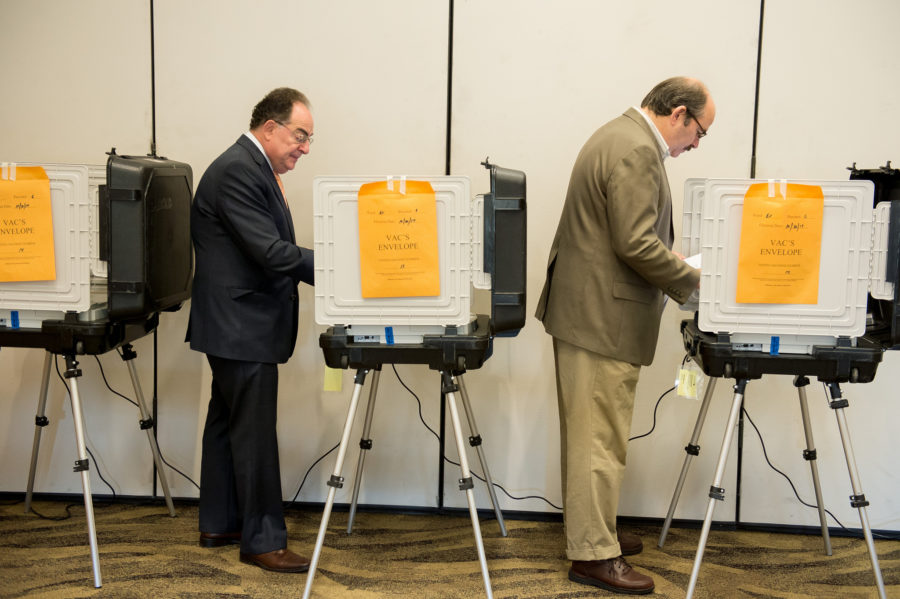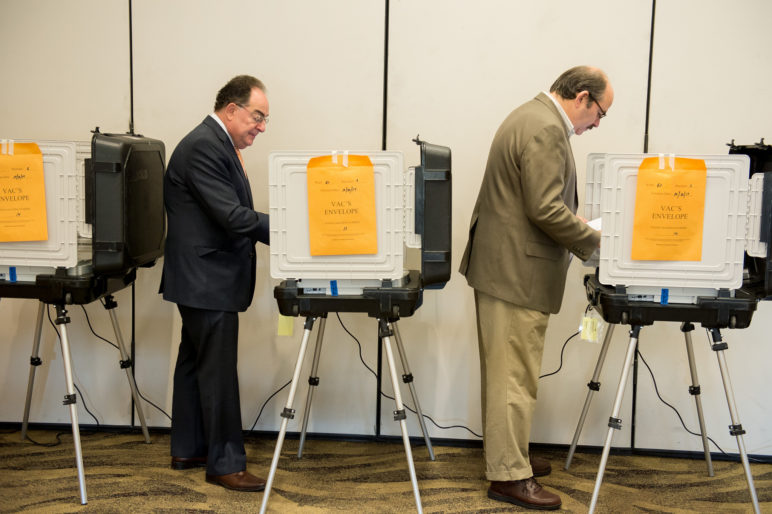This is part one in a four article series about how voters respond to ranked ballots and proportional voting systems. You can read the other articles in this series here: Part 2, Part 3, and Part 4.
US voter turnout is pitifully low compared with other democracies around the world. Though Oregon and Washington have relatively high turnout when compared with other US states (they ranked 8th and 12th, respectively, in the November 2016 election), that isn’t saying much. In Oregon, 64 percent of the voting age population cast votes in the 2016 general election; in Washington, that number was even lower, at 60 percent. Odd-year elections, when Washington voters typically choose their local representatives such as city and county councilors and mayors, usually see even lower voter turnout. Oregon has moved almost all of its races to even years to get around this problem. But in Washington’s November 2017 election, just 29 percent of Washingtonians over the age of 18 sent in ballots.
Instead of making small tweaks to the existing, broken system, a surefire way to convince more people to vote is to make the voting method work for them.
Unfortunately, many efforts to boost participation in the United States, but maintain plurality voting methods, yield small returns. For example, get-out-the-vote (GOTV) campaigns to educate, convince, pressure, or scare potential voters into voting are expensive and typically yield only modest results, if any. Single-winner, majority-minority districts that rely on plurality voting can also engage voters, making it easier for targeted minority groups to elect preferred representatives. But, often the positive turnout boost from districting is short–lived. Even automatic voter registration, which noticeably helps boost turnout, doesn’t improve participation to the degree of fair voting methods.
So how do you improve a system that may inherently suppress voter turnout? Instead of making small tweaks to the existing, broken system, a surefire way to convince more people to vote is to make the voting method work for them.
Voting methods that streamline the voting process into just one election, such as ranked-choice voting, make it easier for more people to weigh in on the whole election process. In addition, proportional and semi-proportional voting systems, such as multi-winner ranked-choice voting, give voters of all stripes a real chance of electing someone who represents them. These systems often yield elevated voter turnout between 5 and 7 percentage points compared with jurisdictions using plurality and majority voting. That increase remains even after several election cycles. (For brevity in this article, I’ll refer to all ranked-choice and semi- or fully-proportional voting methods as “fair voting” methods.)
The first elections following implementation of a fair voting method typically see small increases in ballot marking errors compared with previous elections (usually less than a 1 percentage point difference), but the massive increase in participation swamps this effect. (I’ll look at factors that yield uncountable ballots in fair voting systems in my next article.)
Overall, the data in this article suggest that two-round election systems disenfranchise voters. Plurality voting more generally may also de-motivate voters, making them feel that their votes have no impact on election outcomes. And efforts to boost turnout while maintaining two-round and plurality voting systems have modest impact. Instead, a move away from this antiquated voting system to fair voting methods can have a lasting and positive impact on voter turnout. They give more voters more of a voice.
GOTV efforts typically have small impact
Some of the most common strategies advocates use to raise voter turnout are get-out-the-vote (GOTV) efforts. These include mailing, calling, and showing up on the door steps of potential voters to encourage them to participate. Yet study after study show that most GOTV efforts fail to effect significant behavior change. Emailed GOTV efforts have no measurable impact whatsoever on voter turnout. And phone canvassing and mailers have almost no turnout effect, typically yielding less than 1 percentage point boosts in voter turnout among those who receive calls or direct mail.
An in-person conversation with a political canvasser can be very effective, raising the probability that a potential voter will actually complete a ballot by between 4 and almost 9 percentage points. But not every door knock yields a conversation. Estimating generously that in a typical door-to-door canvass about one of every four door-knocks lead to an interaction, canvassers may have to knock on around 40 to 100 doors to get one more person to vote. (Of course, these studies don’t measure long-term effects or subconscious behavioral change influenced by GOTV contacts.)
Getting at the root of the turnout issue
Voting methods that eliminate low-turnout elections, such as late-summer primaries or winter runoffs, and give voters the chance to weigh in on all stages of the election process on just one ballot massively improve turnout. Any form of ranked-choice voting (RCV)—both single- and multi-winner—can do this, as can other proportional and semi-proportional voting systems. Single-round RCV elections increase turnout by an average of 8 percentage points compared with primary or runoff elections.
How significant of an impact are we talking about? Just 19 percent of Washington’s voting age population mailed in ballots for the August 2017 primary, while 29 percent did so for the November general. That means over half a million November voters—those who didn’t vote in the primary—had no say in who was on their ballot. Instead, a much smaller portion of the population, typically an older, wealthier, whiter portion (also here), narrowed the playing field before everyone else even arrived. By eliminating the primary, Washington could give those more than 500,000 voters a voice in the whole selection process.
Case studies from San Francisco and Minneapolis confirm that voter participation skyrockets when cities eliminate their low-turnout elections (also here). For example, San Francisco saw an estimated 168 percent increase, equivalent to nearly 120,000 voters, in participation in the final round of counting for its 2005 Assessor-Recorder election compared to the number of voters that likely would have turned out for a December runoff to decide the race.
What about racial and economic turnout gaps?
Turnout boosts as a result of a streamlined election process should particularly boost turnout among voters of color who generally experience greater turnout dips than White voters in primary, runoff, and odd-year elections. There’s relatively little data measuring how much this trend has impacted actual RCV elections in the United States. But one example from San Francisco’s 2005 Assessor-Recorder election bears out the point. Turnout in six of the city’s most racially diverse and low-income neighborhoods more than tripled compared with predicted December runoff turnout. Meanwhile, turnout in the city’s wealthier and whiter neighborhoods was more likely to double. That’s not surprising considering that turnout before RCV in the more racially diverse and low-income neighborhoods was much lower than in other neighborhoods.
Giving voters a real chance at representation gets them to the polls
Proportional and semi-proportional voting systems, which change elections from winner-take-all games to opportunities for voters with a variety of viewpoints to win representation, also have a sustained impact on voter turnout, raising it by 5 to 7 percentage points. In contrast, though majority-minority single-member districting plans that maintain plurality voting can help targeted minority groups gain representation, they typically have a much smaller, and less sustained, effect on turnout.
Globally, countries using proportional representation (PR) voting typically see higher turnout compared with those using plurality or majority voting systems, even when controlling for factors such as GDP, level of democracy, and level of competition (see studies here, here, and here). Most estimates put this turnout boost in national elections at 5 to 7 percentage points compared to majority and plurality elections, respectively. Some scholars suggest it could be even higher, perhaps as much as a 12-point increase. There is not as much data on turnout boosts from proportional representation in state and local elections, but they would likely be somewhat more modest. This uptick is likely due to PR boosting other factors associated with higher voter turnout, such as increased voter choice and electorate knowledge, competition, and minority representation, all factors that stimulate greater voter engagement in elections.
To put this in local perspective: to raise turnout of the voting age population in Washington state by 5 percentage points from the abysmal 29 percent turnout rate in the November 2017 election, 280,000 more Washingtonians would need to mail in their ballots. And going by canvassers’ rate of success that we estimated earlier, canvassers would need to knock on something like 11 million doors to make this happen. But there are only about 3 million doors in Washington.
In the United States, jurisdictions that switch from at-large, plurality voting to cumulative voting (a semi-proportional voting method) see a 5 percentage point increase in voter turnout, one that doesn’t wear off even after several elections. These turnout boosts may largely be due to higher turnout among voters of color. For example, data from Port Chester’s first CV election in 2010 showed that first-time voters were significantly more likely to be Hispanic or non-White than White.
Only two jurisdictions in the United States use fully proportional voting—Cambridge, Massachusetts (for city council and school committee), and Minneapolis (for Board of Taxation and Parks Commissioners). Both cities use single-transferable voting (STV). Unfortunately, there is very little data showing how STV impacts turnout in elections for these two bodies; one of the only studies wasn’t able to verify that STV itself boosted turnout in Cambridge, but the system did appear to buffer the city from voter turnout declines in the region. Internationally, STV is not one of the most common forms of proportional voting, so data on the specific impact of STV (as opposed to all methods of proportional representation) on voter turnout is also sparse. At the least, STV in other countries also likely buffers against turnout declines (also here and here). The system may also marginally boost overall voter turnout, and particularly boost turnout among racial and ethnic minorities, as well as among minor party supporters.
Non-proportional fair voting likely doesn’t boost turnout
Like proportional voting methods, instant-runoff voting (IRV), the single-winner form of ranked-choice voting, boosts turnout via elimination of low-turnout elections. But unlike proportional voting, IRV may not itself lure potential voters to fill out their ballots. One study found that cities that implement IRV see a drop in odd-year general election voter turnout of about 8 percentage points, compared to their pre-IRV odd-year general elections, and no impact on turnout in even-year general elections. Other studies have found that IRV has no direct impact on general election turnout.
Turnout boosts after switch to single-member districts are short-lived
In comparison with the strong boosts to voter turnout from fair voting systems, switching to single-member districts (SMDs) produces only a small and brief impact on voter turnout. Generally the turnout boost following a jurisdiction’s switch to SMDs wears off by the second post-redistricting election (see page 77).
Single-member district plans that include majority-minority districts are a common remedy courts prescribe for minority vote dilution. These districting plans give targeted minority voter groups a better chance of electing their preferred representatives in the designated majority-minority districts. But this reform also likely has a small, to negligible, impact on voter turnout over the long-term. Most studies have found little or no causal basis for increased minority participation in the election process as a result of residing in a majority-minority district (some studies have actually found majority-minority districts can suppress voter turnout for Latinos and African Americans). Other studies have found that voters of color may turn out slightly more when district lines place them in districts where a majority of voters are of their same race or ethnicity, but White voters in these districts are less likely to turn out, resulting in little overall turnout change. Either way, the principle finding of research on SMDs and turnout is that they make little difference at all.
Better voting methods change the turnout game
Fair voting methods create marked and long-lasting turnout boosts by streamlining the election process, and giving eligible voters a reason to vote. This impact is much deeper and long-lasting than get-out-the-vote efforts voting advocacy groups typically employ to boost turnout. In addition, fair voting methods have a more clear and durable impact on turnout than the more-popular majority-minority district reforms favored by most activists concerned with unequal representation for voters of color.
In my next article I’ll look at two issues—ballot marking errors and exhausted ballots—that some voting theorists worry could detract from these turnout boosts. Though important, these issues barely move the needle on voter participation compared with the major gains from a streamlined voting process and proportional and semi-proportional elections.
Note on methods
My calculation of how much proportional representation voting could change Washington state voter turnout is based on data from 509 national elections in 20 countries. I divided the number of voters in Washington’s November, 2017 election by Washington’s total voting age population (VAP) from the 2016 American Community Survey.
The study which found a 5 to 7 percentage point increase in voter turnout due to proportional voting divided the number of voters in PR elections by the electorate. The study did not specify whether it defined the electorate as the VAP, or voting eligible population (VEP). The VEP includes all people who are over 18 and meet all other voting requirements. It’s difficult to get accurate counts of VEP, so more than likely the study used the more accessible VAP estimate. One commonly used estimate for VEP for the United States is from the United States Elections Project. This estimate suggests that there are about 345,000 Washingtonians who are 18 or over, but ineligible to vote for some other reason. Using VEP rather than VAP to calculate turnout reduces the number of doors GOTV efforts would need to knock on to create a 5 percentage point turnout boost by about 1 million, to about 10 million total door knocks, still more doors than exist in Washington.
There is very little data on how much PR boosts turnout in state or local elections, though what does exist suggests the boost may be more modest than at the national scale.
Using a more conservative estimate for Washington state of only a 2.5 percentage point turnout increase due to PR voting, or half that observed in national elections worldwide, similarly finds that GOTV efforts cannot hope to produce the same boost in voter turnout as voting system change can. Even using this more conservative estimate, it would still likely require over 5 million door knocks—larger than the number of doors in Washington state—for canvassers to boost turnout by 2.5 percentage points via a door-to-door GOTV canvass. Using VEP, rather than VAP, suggests that GOTV efforts would need to knock on just under 5 million doors to achieve this turnout boost.












RDPence
“Voting age population” is not the target, rather it’s “citizens of voting age.” Factoring out ineligible persons means our current voter participation is not quite as bad as portrayed in this piece.
Ryan Ferris
CVAP (Census) data is available with some guidelines for working with it. Some scholars use CVEP which eliminates ineligible citizens (e.g. felons or felony history in many states) Still, the drop off in between non presidential elections and the “falloff” for any election are huge and seemingly interminable problems. Anything is worth trying. It should be pointed out that Facebook adverts worked well for CA and DJT to both increase supporters and decrease opponent votes.